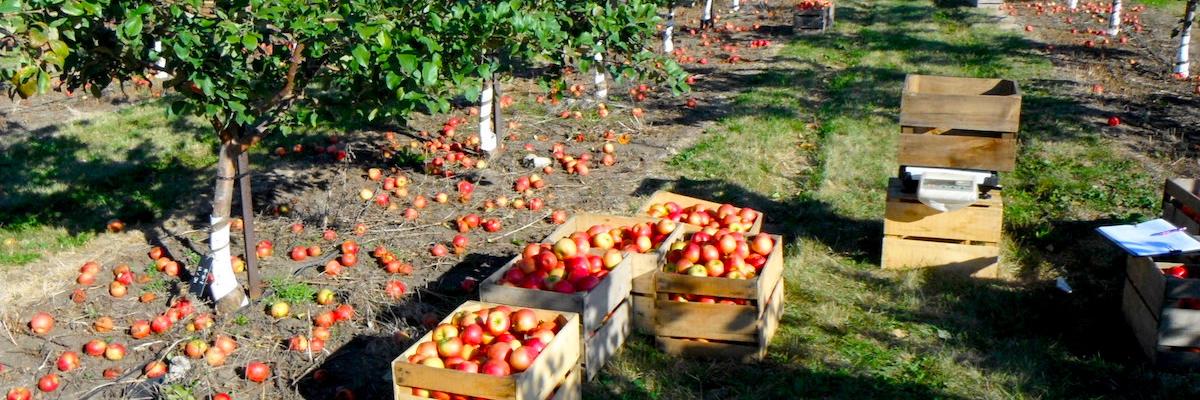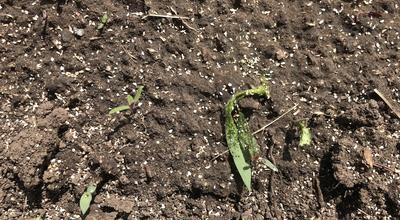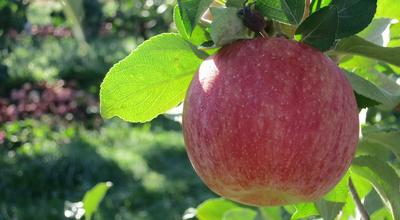Are you thinking about starting an apple orchard to grow and sell apples? That's a big and exciting undertaking! It's great that you're looking around for tips before gettings started, because there are some important things to know about the business of producing and selling apples before investing your time, energy, and money. Here are some things to consider if you are thinking about starting or purchasing an orchard.
Experience
If you have had no previous experience in orchard management, the best way to know what you're getting into is to work for a successful orchardist for a year or more. Attend grower meetings to learn from the experts and meet other growers. Meetings and conferences are usually held during the winter, but even more fun are the field days which are held throughout the season. Get involved in grower associations to find out when various events are held. Check on our events list too.
Orchard Size
Apple production requires a lot of labor, and will take a lot of your time. You'll probably also need additional seasonal help for harvesting and packing the fruit. Although every farm system is unique, 10 acres could be considered a minimum size for a commercial apple-growing business. A 10-acre operation is large enough to use equipment efficiently and implement a continuous orchard renovation program, yet small enough that one person can take care of most of the work. Larger orchards can make more efficient use of machinery and equipment, but will require more hired labor, and more management skill.
Management
Apple growing is an enterprise that requires a great deal of knowledge on the part of the orchard owner or manager. Making a profit growing apples in Minnesota (or anywhere else) requires intense management, from variety selection through planting, training, controlling pests, thinning fruit, harvesting, handling, and marketing. If you are considering orcharding as a career or a business opportunity, you'll need to learn about and keep up-to-date with production practices.
Start-Up Costs
It's going to cost a lot of money to get started. There's really no other way to say it. Be sure you have the capital to purchase and operate an orchard before signing any agreement or sale contract. You'll be making a large investment from the year you plant until the year that crop returns equal or exceed annual expenses. Dwarf trees may begin bearing a small crop their third year in the ground, but will not reach full productivity until the sixth or seventh year after planting. Semi-dwarf or standard trees will take longer to reach full productivity.
Penn State University Extension has some great resources to help you determine costs for establishing and maintaining an orchard, along with other important startup tips. Many of these aspects are the same no matter where your orchard is located.
Orchard Establishment: Site Selection and Preparation
Orchard Establishment: Checklist for New Plantings
Remember that planting year costs include trees, tree guards, stakes, labor to plant and train trees, fertilizer and pesticides (herbicides, insecticides, fungicides, rodenticides, and/or bactericides).
During the early years before your trees come into production, costs include labor for pruning, training, mowing, and pest control. After the fifth year or so when trees come into full production, some costs will increase while yields and income are also increasing. As the trees get larger, they will require more resources for pest management, pruning, and thinning. You might also have to hire honeybee hives to ensure good pollination. Don't forget the labor it will take to harvest all that fruit.
Once you have apples to sell, advertising and packing costs will vary depending on how you plan to market your fruit. A pick-your-own orchard will not have high harvest labor costs, but you'll need people to do things that other orchards don’t, like driving your customers around the orchard, or providing other entertainment to attract customers to your orchard. A pick-your-own orchard is also likely to have higher insurance costs.
Deer Fencing
One site preparation expense that people often forget about is fencing to prevent wildlife from damaging your orchard. Deer fencing is pretty much essential to successful apple production in Minnesota. Young trees in particular are attractive to deer, and can be killed in a single season of heavy browsing. Hanging bars of soap, human hair, or other repellants in the trees might be effective, but it might not.
The Minnesota Department of Natural Resources has a lot of info about planning your strategy for protecting your crop from deer and other wildlife.
Marketing and Income Potential
You could expect to have income from the trees after the fifth year. Yields from dwarf trees planted at a density of 300 to 400 trees per acre in Minnesota range from about 300 bushels per acre to 500 or more bushels per acre. Figuring that a bushel of apples weighs about 40 pounds, an acre of trees at this density should produce at least 16,000 pounds of fruit, and on a good site, with favorable climatic conditions and excellent management, as much as 20,000 pounds.
Not all of the production will be saleable; figure about 60% packout when you make income projections; somewhat less for pick-your-own, since customers will not be as thorough pickers as hired harvesters, and they may eat a significant amount of fruit without purchasing it.
Prices for fruit will depend on how it is marketed: pick-your-own, pre-picked on-farm sales, farmers’ market sales, or wholesale in bulk to a packer. At some pick-your-own orchards in Minnesota, many varieties sell for about $1.00 per pound; pre-picked fruit costs about $1.25. The same fruit, sold wholesale to a packer, might be worth only ten cents per pound.
Some varieties command a higher price than others, prices will vary from year to year, and yields will also vary. Don’t assume that planting all Honeycrisp and no lower-value apples will allow you to beat the average. Offering a wide range of varieties and products is beneficial not only to attract a wide customer base but also to prevent catastrophic failure from pests or diseases. You've probably seen the fall extravananzas that take place at most Minnesota orchards. These businesses have found that a good way to make a profit is by offering a wide variety of fruit, and by having a diverse business that includes other income potential like a bakery, a cider pressing operation, entertainment, or all of the above. Some orchardists grow other fruits and/or vegetables as well as apples.
It makes good business sense to draw up a marketing plan with assistance from a consultant before you plant the first tree. Figure out who will buy your apples and how you will sell them. Decide what will define your orchard and make people want to come to your farm or farmers market stand rather than going to someone else’s or going to a grocery store.
As you pencil out the financial outlook for your planned orchard, check out the Small Business Administration (SBA) for assistance in creating a business plan. The SBA website offers worksheets, online courses, videos, chat sessions and other resources to help you through the process of creating a successful business.
Additional Information
Many books, trade publications, and magazines from around the country are available for more information about growing apples. Spend a lot of time reading and learning all you can before making a final decision about starting an orchard.
Here are some of our favorites.
Books
These three titles are classics. They cover the fundamentals of pomology (the science of growing fruit) and that hasn't really changed. These are the most worn out books on our shelves so that must mean they're good. You might have to do some searching to find a copy, but it'll be worth it. Every serious fruit grower should have a copy of these.
Temperate Zone Pomology by M. N. Westwood. 2009. Timber Press. Portland, Oregon. An in-depth book about both the culture and physiology of fruit growing.
Modern Fruit Science by Norman Childers.1995. Horticultural Publications. Rutgers University. New Brunswick, New Jersey. A very practical hands-on guide.
Growing Fruit in the Upper Midwest by Don Gordon. 1997. University of Minnesota. Focuses on site selection, soil types, pruning, fertilization, harvesting, pests, preventing winter injury, and proper cultivar selection for fruit production in Minnesota, Wisconsin, Iowa, South Dakota, and North Dakota.
Magazines
The American Fruit Grower is a monthly publication written for commercial fruit growers containing information on technology, research findings, biotechnology, and pest control.
Good Fruit Grower is based in Washington. This publication focuses on world and local production issues and research findings.
Fruit Grower News is a monthly publication with an edition that can be viewed online.



